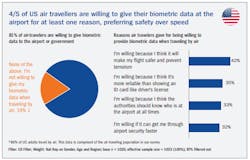Traveling, particularly by air, is fraught with tension. The tension is valid: in 2018 the Transportation Security Administration (TSA) confiscated a record-setting 4,239 firearms in carry-on bags, 86 percent of which were loaded. TSA personnel also discovered items such as smoke grenades, lighter fluid and fireworks. The U.S. Department of Homeland Security (DHS) is seeking to improve aviation security worldwide, acknowledging that, “recently evaluated intelligence indicates terrorist groups continue to advance multiple efforts to target the aviation sector and are seeking ways to circumvent aviation security.”
The good news is that there is definitive movement to strengthen security worldwide by leveraging emergent technologies such as biometric authentication. Consumers are increasingly willing to cooperate with such technologies in the interest of their personal safety. For example, a full 81 percent of American respondents to the 2019 Unisys Security Index report that they are willing to give their biometric data at the airport. The number one reason for this willingness is that they believe it will make flights safer and prevent terrorism. Drilling down even further, 48 percent of Americans are specifically open to the use of facial recognition software at airports to verify their identity in security lines or when boarding an airplane.
Respondents who do not want to give their biometric data for air travel most often cite lack of trust in government or airport authorities, or concerns that the data will be lost or hacked. However, acceptance and adoption will likely grow steadily as consumers see the benefits of biometrics at the airport, including ease of use, streamlined processing and increased security. The same initial hesitancy was displayed when TSA PreCheck and the Global Entry program were first launched; yet, today, these programs – which utilize fingerprints as a biometric – are in common usage.
Why the Move to Biometrics Has Been Slow
The movement toward the use of biometrics for airport security has been slow because of the multiple factors involved. First, consider the stakeholders. The personal safety of consumers can only be assured if governmental agencies, airlines and airports across international boundaries are all willing to work together toward a common goal, and coordinating with that many potential entities is no easy task.
The second factor is the data. Biometric data and other forms of identification are collected by government agencies around the world, but data sharing between countries, agencies, airlines and airports has been and continues to be a major point of discussion. Questions about whether passenger data will be in the cloud or on premise, as well as what data organizations need to ensure passenger safety continue to persist. Security is the overarching concern, as either a data breach or the lack of critical data would cause irreparable harm to countries, consumers, agencies, airlines and airports alike.
Third, the technology must be taken into consideration. Biometric technology has been steadily maturing over the past two decades. That being said, for most of the years following 9/11, the use of biometrics was not a seamless process: it would take time for passengers to be scanned and the data interpreted, which passengers considered an inconvenience. Only in recent years has the technology advanced enough to provide both the speed and accuracy necessary to be a viable option in the demanding airport environment.
Finally, the infrastructure of airports has been a limiting factor. Airports were originally concerned primarily with aircraft in mind (e.g., landing, loading/unloading, taking off). Passengers were very much a secondary focus. Consequently, the architecture of the airport and its IT systems were not designed to handle the technology, data and security concerns of passenger travel today. To get on board with biometrics requires a significant upgrade to the IT systems in most airports.
Biometrics Cleared for Take-Off
Given the factors noted above, there are several steps airports can take to adopt biometric technology as a way to both strengthen security and ensure a seamless passenger travel experience. Of primary importance is to actively work with stakeholders to establish standards and protocols on how passenger data will be shared and secured. This alignment needs to happen internally within a country first; only then can cross-border standards and protocols be successfully put in place. Standards and protocols, however, do not emerge automatically: they must be forged with intentionality. Airports must play an active role in this work.
Simultaneously, airports need to make IT modernization a priority. The fact is, even if standards and protocols are agreed upon, government agencies will not share sensitive data with an airport unless the airport can prove that there are security features in place to protect the data at rest and in motion. Such IT modernization includes:
- Choosing biometric equipment that can be integrated seamlessly into the IT architecture
- Leveraging advanced analytics that provide reliable algorithms for producing identity matches
- Deploying end-to-end security that encompasses multichannel and multifactor authentication, real-time monitoring, microsegmentation and protection against both external and internal threats
- Utilizing a cloud that is both secure for sensitive data and compliant with existing and emerging data privacy regulations
Clearly, securing airports through the use of biometrics to better ensure passenger safety will not happen overnight. But it will happen: the data exists, the technology is present and the need is great. By working together across airports, across agencies, and across borders, safety and security can become the hallmarks of the air travel industry.
Dheeraj Kohli is Vice President and the Global Head of Travel and Transportation for Blue Bell-based Unisys Corporation. He can be reached at [email protected].







